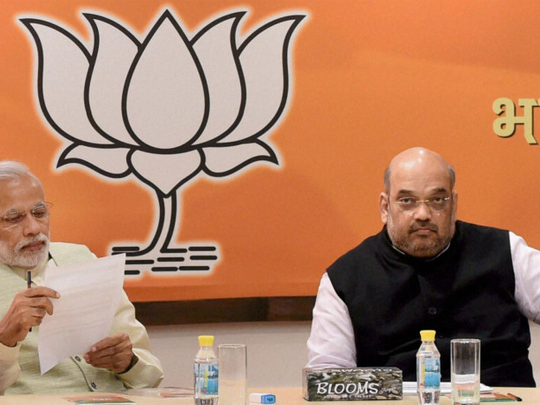
The honeymoon seems to be over. And if the ruling Bharatiya Janata Party (BJP) in India has found it to be too short-lived, then it has only itself to blame.
It’s just a state election, one might say. Fair enough.
But the results of the Bihar assembly polls have clearly showed that what has happened in this eastern Indian state may well and truly be a microcosm of what the overriding sentiment is within the frame of that larger canvas called India. And that sentiment is definitely one of anguish and concern — something that has been addressed in no uncertain terms through the power of the ballot, handing the Janata Dal United-Rashtriya Janata Dal-Congress grand alliance a thumping victory.
Coming back to anguish and concern. For the last couple of months, India witnessed a rather unsavoury and unfortunate polarisation of its secular, pluralistic socio-political space by elements of an ultra-right propaganda machinery that first showed itself up as an obnoxious fringe and then gradually tried to take centre stage – threatening to co-opt the moderate voice of scruples within India’s ruling party at the Centre.
It’s just a state election. Fair enough.
But it was indeed shocking and deeply disappointing to see how a discourse built so assiduously on the promise of “achhe din” (“better days”) — during the high-octane campaigning for last year’s general elections — degenerated into utter profanity and reached a dead-end in the dreary sand banks by the Falgu and Sone rivers! The campaigning for Bihar state elections kicked off with development as the main plank, but by the time polling reached the third stage, the attempt to play the caste card was all too apparent. And as if that was not enough, by the time ballots were about to be cast for the fifth and final phase, attempts to polarise voters along communal lines were so blatant that the tension within the saffron ranks became all too palpable. The way the BJP went all-out to pander to religious sentiments in the last phase was a clear indication that the party mandarins had probably got an inkling that they had failed to strike a chord with the Bihar voter. By that time, the atmosphere all over the country had already been vitiated over the murder of a liberal academic, the Dadri lynching over alleged beef-eating, the slew of awards returned by various artists and luminaries protesting growing intolerance, the ink attack over a book release, the tirade against Shah Rukh Khan for what he termed as “extreme intolerance” in India ... As a result, what was supposed to be a heady concoction of a winning recipe for BJP got severely diluted in the din of a needless ‘us-vs-them’ slanging match.
Lack of improvisation
It was just a state election. Fair enough.
But see how desperate the BJP top brass was to try and seal a win in this crucial cow-belt state. And it was this desperation that put paid to the Modi-Shah combination’s sales pitch. Despite the fact that the party was up against such an earthy, son-of-the-soil combination of Nitish Kumar-Lalu Prasad Yadav, BJP preferred not to project anyone as a potential chief ministerial candidate. It had a seasoned partyman like Sushil Modi, a former deputy CM and finance minister of the state. It had a veteran like Union minister Ravi Shankar Prasad, who is quite a known face in the state. Yet, the saffron brigade preferred not to make any changes to the script of the campaign for last year’s Lok Sabha elections, banking heavily on Prime Minister Narendra Modi and party president Amit Shah — as if there was no tomorrow.
It was lack of improvisation and the reluctance to customise the party’s interface, in keeping with the dynamics of micro-level politics, that saw the BJP practically decimated at the hustings. Modi and Shah, particularly the former, are mascots that the party ought to have used sparingly in the campaign. Unlike the elections that took place in Haryana, Maharashtra and Rajasthan, the Bihar polls came almost 18 months after the 2014 Lok Sabha elections. And therefore, it was only natural for the ‘Modi wave’ to have receded in the meanwhile. It was rank-bad strategy in the first place to keep projecting Modi as the party’s one and only match-winner. Moreover, no one knew it better than the BJP top brass that the party had come a cropper on many of its 2014 poll promises — chief among which were economic development and the promises of retrieving black money.
So the BJP actually had very little to speak for itself in real terms and it would have been only natural for some degree of fatigue and impatience to have already set in among the electorate. Modi held 31 rallies all across Bihar, the maximum by any PM in a state election, while Shah camped in Bihar for several weeks. But the end result showed quite conclusively that the electorate was not impressed with the duo’s promises. It was the sameness of the BJP campaign that gave the Nitish-Lalu combine a game-changing edge.
It was just a state election. Fair enough.
But just think of what Shah had to say in one of his rallies: “The results of these elections will be declared in Patna, and if BJP loses, crackers will go off in Pakistan!”
With such a jaundiced view, perspectives are bound to get foggy and priorities misplaced. And the sagacious Bihar voter preferred not to put his or her money on such intemperance. Kudos.
Follow Sanjib Kumar Das on Twitter










